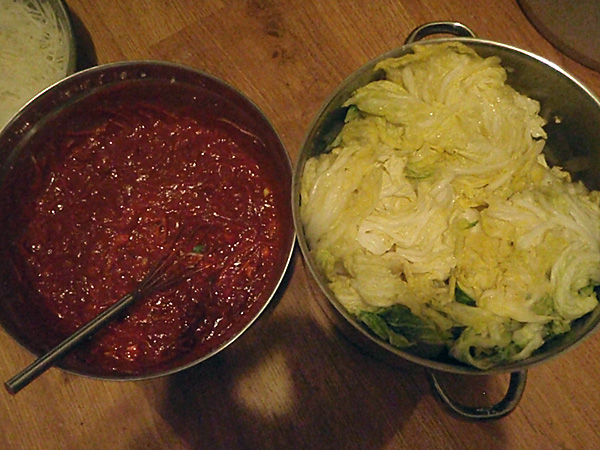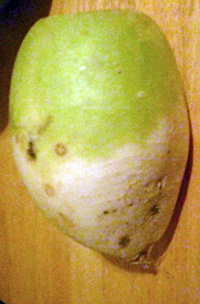
Sandorkraut, or Sandor Ellix Katz, is a curious figure. A self-described “fermentation revivalist,” Katz has taken the foodie world by storm. He made 2009’s CHOW 13 for his food activism and promotion of fermentation to the point it’s been dubbed “the new bacon.” After hearing all the fermentation hype, purported health benefits, and preservation effects (let’s face it — if you like food, you will never have enough fridge space), fermentation seemed a worthy cause.

Thus, we focus on kimchi and kaktugi (spicy fermented radish), the high-fiber, spicy-sour Korean side dishes considered to be among the “world’s healthiest foods.” Katz’ “recipe” proved to be a loose framework to transform vegetable scraps into their pickled relatives — not a particularly high level of Korean kimchi authenticity. Instead, we start from a how-to video from Maangchi, a home cook who has developed a remarkable following for her recipes and YouTube videos.
Producing the kimchi and kaktugi seems far more daunting than it truly is. We’ve edited Maangchi’s recipe to reflect the stock of a local Korean grocery store, Kim’s Oriental Market of 689 Snelling Ave N, St. Paul. Out went the Asian chives, as did the fresh oysters; white radishes (which have a sweeter, milder flavor than their red-skinned cousins) and kochukaru (coarse red pepper flakes) are imperative and easy-to-find. If you’re not fortunate enough to have a nice stoneware crock, the poor man’s alternative will do — buy gallon-sized glass jars of pickles, dispose of their contents, and fill them with a solution of bleach and water for a few days to provide perfectly sized storage containers.
Kimchi and Kaktugi (Spicy Fermented Cabbage and Radishes)
Makes around two gallons (one of each kind)
2 heads of Napa cabbage
Kosher or pickling salt
3-3 ½ white radishes, peeled and diced into one-inch cubes
Rinse the cabbage to remove any dirt. Cut the cabbage in half; then cut in half again. In a large (preferably glass or stoneware, as they are nonreactive) bowl, sprinkle salt between each cabbage leaf, concentrating the salt at the base of the stalk. Pack the cabbages into the bowl and leave to sit for four hours, rotating the cabbage halfway through. Sprinkle the cubed radishes with ½ cup of salt and do the same — let them rest for four hours, mixing the radishes after two hours. Near the end of this four-hour salting period, prepare the paste (below).

1 c garlic, chopped
1 medium onion, chopped
1 1-inch piece of ginger, minced
3 c water
½ c sweet rice flour (Mochiko) or regular all-purpose flour
¼ c sugar
1 c fish sauce
3-4 c coarsely ground hot pepper flakes (kochukaru) — buy these from a Korean market
7 green onions, coarsely sliced on the diagonal
Purée the garlic, onion, and ginger in a blender or food processor. Set aside. Heat the water and flour together, stirring constantly, until thick and softly boiling. Add the sugar and stir about a minute, or until it dissolves. Transfer to a large bowl and let cool. To the water-flour-sugar “porridge,” add the puréed garlic, onion, and ginger; stir in the fish sauce, hot pepper, and green onions. This constitutes the flavor paste for both the kimchi and kaktugi.
After the four hours of salting are up, wash the cabbage and radishes in a colander with water until they lose the slippery feeling and super-salty taste. Trim the hard base from the cabbage and chop crosswise into roughly bite-sized pieces. Mix the cabbage and half of the kimchi paste in a large bowl, coating each leaf evenly. Then pack the cabbage into a gallon-size jar (or crock, or other container). Do the same for the radishes with the remaining paste, and set the jars aside in an unobtrusive corner (room temperature or slightly cooler) for a day or two.
Here comes the tricky part: making adjustments. After a day or two, taste the kimchi and kaktugi to see if you like the flavor balance. Sometimes the mixture could use more fish sauce, or perhaps more pepper — use your intuition, and keep in mind that the flavor will continue to change. As time goes on, you’ll find that the smell becomes more pungent and the taste more acidic — this is a natural part of the fermentation process, and a desirable effect to achieve. Put the “finished” product in the refrigerator when you’re pleased with the sourness of the vegetables. You can eat your kimchi right away, though it should reach its peak flavor after about two weeks in the refrigerator. As long as it remains refrigerated, it should keep indefinitely.
After a couple of attempts, my kimchi has garnered praise from a few Korean friends, who say it can compete with the best of them! The simple process, as time-consuming as it seems, is well worth it.
Further reading:
David Chang’s kimchi recipe (in his newly-released Momofuku cookbook or here)
Sandor Ellix Katz’s “Wild Fermentation,” published in 2003, or his website

Congratulation on your successful kimchi making! 2 huge jars of delicious kimchi: napa cabbage kimchi and radish kimchi in your refrigerator! I know how you feel now. : ) It looks so good!
As someone who discovered, has followed, and has become a fan of Maangchi’s kimchi recipe myself, I love the fact that you’ve discovered it. And yes, the American “health food” world, Katz included, has a bizarre habit of throwing minute amounts of garlic and pepper into otherwise ordinary sauerkraut and calling it “kimchi”, so I’m glad you left that behind and found the real thing.
BUT, I cannot sit by in silence while you blithely and breezily boast about what I know to be a tragic and unnecessary mistake. You write:
“We’ve edited Maangchi’s recipe to reflect the stock of a local Korean grocery store, Kim’s Oriental Market of 689 Snelling Ave N, St. Paul. Out went the Asian chives, as did the fresh oysters…”
Let me get this straight–St. Paul doesn’t have oysters? Seriously? Trust me on this one–the oysters make the kimchi. By themselves they elevate it from “good” to “outstanding”. What you did was akin to someone nonchalantly deciding to make chocolate mousse without chocolate, or cassoulet without the confit de canard. Find a few oysters, please.
I would also be surprised if Kim’s establishment really didn’t have garlic chives (Bu Chu), which also add a lot to the dish, but if he really doesn’t, don’t just omit them–double the amount of green onions. Bon Appetit!
While I completely agree with you that oysters are delicious in kimchi, I would refute your comment that oysters are to kimchi as chocolate is to chocolate mousse — there are so many different kinds of kimchi and Korean side dishes that vary by region that, to essentialize one variety as the “one, true kimchi” would be incorrect. My Korean friends will back me up on this — leaving the oysters out doesn’t sacrifice the kimchi’s authenticity; instead, it replicates a different region’s traditional kimchi flavor. As for the chives and oysters, they are indeed available in the Twin Cities — however, not at the tiny corner store that we visited.
Hello Maja,
The “chocolate mousse without chocolate” was indeed a poor metaphor; I accept that oysters are not essential to kimchi as, perhaps, garlic or red pepper are. I should have found, for comparison, something that, while not exactly essential to a dish, nevertheless improves it so dramatically that omitting it is rarely a good idea.
I lived in Seoul for two years without once seeing any oysters, or any other seafood, in kimchi, but when I returned to New York I found that the kimchi in Korean restaurants here–which my Korean friends, who are positive epicures, declared to be better than in Seoul–had oysters. And here I felt that I had finally discovered the “point” of kimchi. Just as the garlic and pepper make it far more interesting than mere sauerkraut, so the presence of seafood lifts this “maritime” kimchi above kimchi that doesn’t have any. After all, most of the ingredients of kimchi are “hot”, so something “cooling” and fresh, like oysters, provides a welcome balance.
I would never call oyster-less kimchi inauthentic. Just not as good. And I felt that the sentence “out went the…fresh oysters”, had an air almost of “good riddence” or “off with her head” about it, suggesting that perhaps that oysters were an irrelevant or an afterthought. Anyhow, I just wanted to share my love for the oysters and what they do for the dish.
As for the garlic chives, I’m not sure whether I would even notice their absence with all the other stuff, but a Korean friend, when I was enumerating the ingredients and came to the bu chu, said: “be sure to use lots of that!”